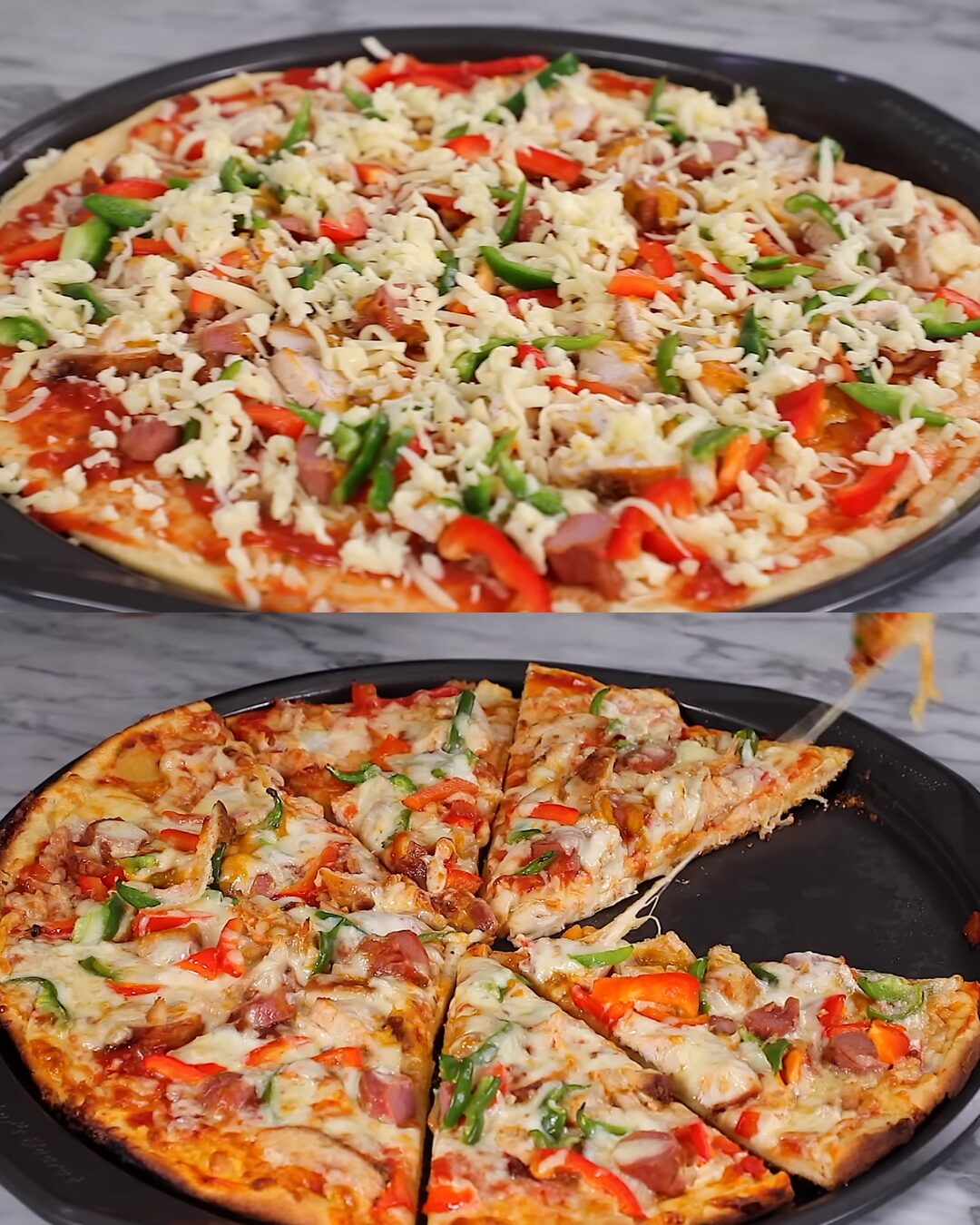If you’ve ever dreamed of making your own pizza at home but don’t have a pizza oven—or even a regular oven—you’re in for a delicious surprise. This recipe shows you how to create soft, cheesy, and mouthwateringly good pizza using both a stovetop method and a traditional oven method. Whether you’re a college student without an oven or a busy home cook who wants quicker results, this recipe will become your new go-to.
From preparing the homemade pizza dough from scratch to whipping up a hearty vegetable-based sauce and choosing between two easy cooking methods, this guide has everything. Learn how to make your own pizza that’s bursting with flavor, completely customizable, and far better than takeout!
Preparation Time: 30 minutes
Cook Time: 20–25 minutes
Total Time: 1 hour 45 minutes (including rising)
Yield: 4 medium pizzas
Cuisine: Italian-inspired, Homemade Fusion
Ingredients
For the Dough
-
3½ cups (440 g) all-purpose flour
-
1 tablespoon instant yeast
-
1 tablespoon sugar
-
1 teaspoon salt
-
1 large egg
-
1¼ cups warm milk
-
3 tablespoons unsalted butter, softened
For the Sauce
-
1 tablespoon vegetable oil
-
1 small onion, finely chopped
-
1 carrot, diced
-
1 stalk celery, diced
-
½ red bell pepper, chopped
-
½ green bell pepper, chopped
-
2–3 ripe tomatoes, chopped
-
1 scotch bonnet or chili pepper (optional, for heat)
-
½ teaspoon dried thyme
-
½ teaspoon curry powder
-
1 seasoning cube (or 1 teaspoon bouillon powder)
-
Salt to taste
-
1 cup water
For the Toppings
-
1–2 cups cooked chicken breast, diced
-
½ cup cooked sausage slices
-
½ cup cooked bacon pieces
-
1–2 cups grated mozzarella cheese
-
½ red bell pepper, sliced
-
½ green bell pepper, sliced
-
Optional: mushrooms, olives, sweetcorn, onions
Step-by-Step Directions
1. Make the Pizza Dough
Start by preparing the dough. In a large mixing bowl, combine the flour, instant yeast, sugar, and salt. Stir well to blend all the dry ingredients evenly.
Make a well in the center and crack in the egg. Stir to start combining, then pour in the warm milk and mix again.
Add the softened butter last and use your hands to bring everything together. Once a dough begins to form, transfer it onto a clean, lightly floured surface and knead for 10 to 12 minutes.
Tip: Kneading is essential for developing gluten, which gives the dough elasticity and softness. The dough should become smooth, stretchy, and bounce back slightly when poked.
Form the dough into a ball and place it back in the bowl. Cover it with a clean kitchen towel and let it rise in a warm area for about 1 hour, or until it doubles in size.
2. Prepare the Pizza Sauce
While the dough is rising, start on the pizza sauce.
Heat vegetable oil in a pan over medium heat. Sauté the chopped onions for a few seconds until fragrant. Add in the carrots and celery and cook for another minute before tossing in the chopped bell peppers and tomatoes.
Season with thyme, curry powder, seasoning cube, and salt. Stir everything well, add 1 cup of water, cover, and simmer for 5 minutes.
Once the vegetables are soft, transfer everything to a blender and puree until smooth. You should get a creamy sauce. Let it cool, then transfer to a bowl or airtight container.
Make-Ahead Tip: This sauce stores beautifully in the freezer for up to two months. Double or triple the batch and portion it out for future pizzas or pasta dishes.
3. Prepare the Proteins and Toppings
Cut your chicken breast into thin strips or small cubes. Season with salt and pepper. In a hot, lightly oiled pan, pan-sear the chicken for 3–4 minutes on each side until golden and cooked through.
Sauté your sausage and bacon pieces until lightly crispy and set them aside as well.
Grate the mozzarella cheese using the large holes of a box grater. Slice the bell peppers and any other vegetables you want to use.
4. Roll and Portion the Dough
Once the dough has risen, punch it down and turn it out onto a flat surface. Divide it into four equal portions. If you don’t plan to use all the dough immediately, wrap the portions in cling film and freeze them.
Roll out one portion into a flat circle or rectangle, depending on your pan or tray shape. Keep it about ¼ inch thick.
Method 1: Stovetop Pizza
No oven? No problem. Here’s how to cook your pizza entirely on the stovetop.
-
Heat a large non-stick or cast-iron pan over low heat and coat it generously with vegetable oil.
-
Gently lift your rolled-out dough and place it into the pan.
-
Cook one side for about 3–4 minutes or until lightly browned.
-
Flip the dough and immediately begin layering the toppings:
-
Spread a generous spoonful of pizza sauce across the base.
-
Sprinkle on mozzarella cheese.
-
Add the cooked chicken, sausage, bacon, and sliced vegetables.
-
Finish with more cheese on top.
-
-
Cover the pan with a tight lid and allow it to cook on the lowest heat for another 3–5 minutes. This traps steam, melts the cheese, and gently warms the toppings without burning the crust.
Pro Tip: Do not increase the heat. Low and slow is key for a golden crust and perfectly melted cheese.
Slide the pizza onto a plate, slice it, and serve immediately. It’s soft, crisp underneath, and absolutely addictive.
Method 2: Oven-Baked Pizza
Prefer the classic oven-baked method? Here’s how:
-
Preheat your oven to 220°C (425°F).
-
Lightly grease a pizza tray or baking sheet with oil or cooking spray.
-
Lay your rolled-out dough on the tray and spread it evenly.
-
Top it in this order: pizza sauce → mozzarella cheese → proteins → vegetables → more cheese.
-
Bake in the preheated oven for 12–15 minutes, or until the crust is golden and the cheese is bubbling.
Let it cool for a couple of minutes before slicing and enjoying!
Nutritional Information (per serving, approx.)
-
Calories: 520
-
Protein: 26g
-
Carbohydrates: 48g
-
Fat: 24g
-
Fiber: 4g
-
Sodium: 680mg
-
Sugar: 4g
Origin and Popularity
Pizza originated in Naples, Italy, as a humble flatbread topped with simple ingredients. Today, it’s a global favorite, evolving across cultures and regions. What makes this version unique is its flexibility—it’s a hybrid of traditional Italian preparation and innovative home-style technique.
Using stovetop cooking to make pizza is popular in places where ovens are uncommon or when you need a quick, heat-efficient meal. It’s an ideal solution for people in dorm rooms, small apartments, or during summer months when you want to avoid heating the house.
Why You’ll Love This Recipe
-
No oven required (if using stove method!)
-
Customizable toppings
-
Soft and chewy dough every time
-
Perfect for kids, family gatherings, or solo indulgence
-
Freezer-friendly dough and sauce
-
Better than delivery—and cheaper!
Health Benefits
-
Homemade is healthier. Control the amount of salt, sugar, and fat.
-
Vegetable-rich sauce. Packed with nutrients from bell peppers, carrots, celery, and tomatoes.
-
Lean protein choices. Chicken breast adds satisfying protein without heavy fat.
Serving Suggestions
-
Serve hot with a fresh garden salad
-
Pair with garlic dipping sauce or herbed olive oil
-
Enjoy with a light soda or sparkling water for balance
-
Slice into small wedges for party-style finger food
Cooking Tips
-
Let the dough rise in a warm place—inside a turned-off oven or near a window works well.
-
Don’t overload with sauce or toppings; moderation prevents soggy dough.
-
If making on the stove, always use low heat to avoid burning.
Variations
-
Vegetarian: Skip the meat and add mushrooms, olives, or artichokes.
-
Spicy: Use hot sauce, chili flakes, or spicy sausage.
-
Cheese-lover’s version: Mix mozzarella with cheddar or provolone.
-
Thin crust: Roll out the dough thinner and bake slightly longer.
-
Mini pizzas: Divide the dough into smaller rounds for personal-sized servings.
Conclusion
Homemade pizza doesn’t have to mean complicated dough techniques or fancy equipment. Whether you choose the stovetop version or opt for the oven-baked classic, this pizza recipe delivers every time. With soft, chewy dough, a vibrant vegetable-loaded sauce, savory protein toppings, and gooey cheese, it’s the ultimate comfort food made right in your kitchen.
Next time you’re craving pizza, skip the delivery app. Grab a pan—or your oven tray—and get cooking!
Frequently Asked Questions
1. Can I make the dough ahead of time?
Yes! Freeze it after kneading and thaw it at room temperature when ready to use.
2. What kind of flour should I use?
All-purpose flour works best. Bread flour will give you an even chewier texture.
3. Can I use whole wheat flour?
Yes, but expect a denser dough. You can mix whole wheat and white flour for balance.
4. How do I store leftovers?
Wrap in foil or place in an airtight container and refrigerate for up to 3 days.
5. Can I reheat the pizza?
Yes—use a pan on low heat or pop it in the oven at 180°C (350°F) for 5–8 minutes.
Advertisement
6. Is it okay to skip the egg in the dough?
Yes. The egg adds richness but isn’t essential. You can leave it out if needed.
7. What if I don’t have mozzarella cheese?
Use any melty cheese—cheddar, provolone, or a blend works fine.
8. Can I use tomato paste instead of making sauce?
Yes. Mix tomato paste with a little olive oil, garlic, and herbs to make a quick sauce.
9. How thin should I roll the dough?
About ¼ inch thick. Too thin and it may tear; too thick and it won’t cook evenly.
10. Can I use a tortilla or flatbread instead?
Absolutely! Great for ultra-quick stove-top pizza with minimal effort.

